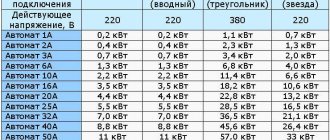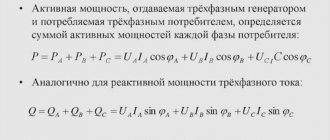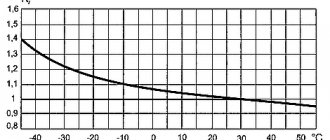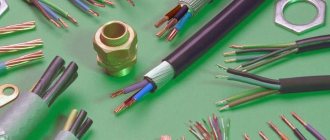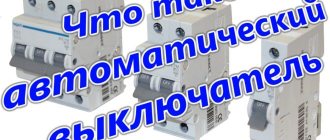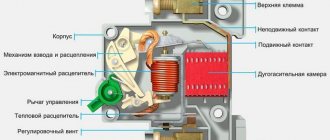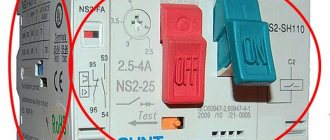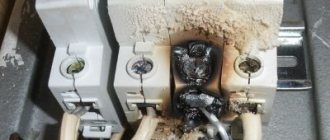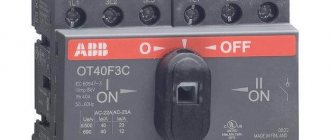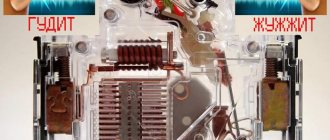The C16 circuit breaker is a 16-amp circuit breaker belonging to the category of medium power switches. Used to protect the network from short circuits, overloads, and power surges. Can be used as a switching device (to turn on or off the network load).
Design and principle of operation of a 16-amp circuit breaker Source uk-parkovaya.ru
What is important to know when connecting electrical appliances
So, having calculated the approximate rating of the required machine, you need to give an explanation regarding the power. Many people wonder whether it is possible to plug in very powerful electrical appliances into a regular outlet, such as an electric boiler, for example.
According to the rules of the PUE, connecting an electric boiler with a power of more than 3 kW to a regular outlet is unacceptable. And each outlet has its own specific characteristics. Most often, home sockets are rated at 16 amperes, and, therefore, electrical appliances with a power of no more than 3.5 kW can be connected to them.
Therefore, any more or less powerful electrical appliance must be connected only through a separate circuit breaker. Moreover, it is the phase wire that is supplied to the circuit breaker, and not the working zero. Thus, knowing the approximate power of the equipment, you can easily calculate the rating of the circuit breaker.
Modular automatic machine C16
Modular automatic machine C16
The device is designed to protect power networks and connected equipment from overloads, failures, and voltage surges. A 16A automatic machine can be purchased at any electrical store; prices vary - they depend on the main characteristics of the device, the number of working poles, and the recognition of the manufacturer. The main indicator of cost is the value of the breaking capacity of the device and its switching value.
The C16 automatic machine is called modular due to certain qualities. Each of the poles of the device is presented in the form of a separate standard module, that is, multipolar devices are made from several separate single blocks (modules). Accordingly, such a 16-amp machine has a different body structure and assembly format. For example, in a molded box the device is presented as a single monolithic device - it cannot be disassembled, unlike other models.
How to choose a current circuit breaker?
On the front side of the circuit breaker housing, manufacturers indicate important and at the same time incomprehensible designations for the average person. In the photo below, I specially circled it with a red frame; the designation indicates the rated current of the machine, which is measured in amperes
This is the most important parameter that you need to pay attention to first.
The letter located to the left of the rated current indicates the multiple of the EmR cut-off current (Iotc) in relation to the rated current of the machine. That is, in simple terms, when a short circuit current occurs, the EmR indicates the time of instantaneous operation of the machine. These letters are different, the most popular are the letters “B” Iots = 3...5In, “C” Iots = 5...10In, and “D” Iots = 10...20In.
Machines with the letter "B". They are mainly used in old residential buildings in which the electrical wiring has not been reconstructed. They are often used in country and rural houses that receive power from overhead lines that are very long.
I would also like to draw your attention to the fact that the price of such machines with the letter “B” is slightly higher than with the letter “C” and they are not on sale, only on order
Slot machines with the letter "C". They are the most common and commercially available. They can be used in electrical networks that are in satisfactory (good) condition.
Machines with the letter "D". Due to the high cut-off current ratio (10...20In), such machines are used in industry to protect lines that have large starting currents, which arise, for example, when starting powerful electric motors. Therefore, they have no place in residential buildings!
So, we figured out the letter, now we move on. Before choosing an automatic circuit breaker, you need to take into account the cross-section of the wires, that is, the cross-section of the electrical wiring cable that is located in your house or apartment.
Adhere to the following ratios:
Calculation of the machine according to the cross-section of the electrical wiring.
If the cross-section of the copper core is 1.5 mm square (aluminum 2.5), select the rating of the machine 10A, area of use, lighting.
If the cross-section of the copper core is 2.5 mm square (aluminum 4.0), select the rating of the machine 16A, area of use, sockets.
If the cross-section of the copper core is 4 mm square (aluminum 6.0), we select the rating of the machine 25A, area of use, water heaters up to 5 kW.
If the cross-section of the copper core is 6 mm square (aluminum 10), we select the rating of the machine 32A, area of use, water heaters more than 5 kW, electric stoves.
If the cross-section of the copper core is 10 mm square (aluminum 16), we select the rating of the machine 50A, area of use, entry into apartments with electric stoves.
Scope of application
Functionally, the device performs a protective function in relation to wires. During a short circuit or overload, the core heats up, the insulation melts and then ignites. To prevent this from happening, install a circuit breaker that turns off before the voltage reaches the rated limits for the wire.
C16 circuit breakers are used as an input device in front of the meter. It is installed in panels of apartments, private houses, and offices. As a rule, the device is connected to sockets for electrical appliances.
Important! If a block of 2-5 sockets is connected to one cable, then a separate machine is installed. The same applies to the washing machine.
Load distribution
Features of switches
Circuit breakers are made of materials that are completely harmless to human health. Self-extinguishing thermoplastic is used in the manufacture of the device body. It is able to withstand very high temperatures. Its contacts are made of copper plates, silver plated for better contact and durability.
The design of the circuit breaker contains a special thermal relay, which is activated when the current flow exceeds the norm, and the electrical circuit opens without causing a short circuit. The higher the current indicator, the faster the operation speed of the machine. The count goes on in fractions of a second.
The scope of use of automatic switches is very extensive and extends from their installation in incoming electrical panels to distribution boards of apartments or houses. To use circuit breakers, special distribution boards are produced with already installed DIN rails for the required number of circuit breakers. The buyer only needs to choose the one that meets his wishes and install the shield in the apartment or house.
Despite the apparent simplicity of using circuit breakers, it is better to entrust the connection of a 16-amp circuit breaker to a specialist.
In terms of rated current, circuit breakers differ both in current strength (rated from 1A to 6300A) and in the load on the circuit (220V, 380 and 400V). In addition, switches are usually distinguished by their response speed.
Design features of the device
The device consists of two main parts. The first is the working part, and the second is the protective part. The first includes the machine itself, with a release mechanism, and a reset rail. Most often, two- and four-pole circuit breakers are used.
The release mechanism consists of the following elements:
- Electromagnetic tripping device.
It will de-energize the electrical wiring if a short circuit occurs.
- Thermal release device.
It starts working when the protected group is rebooted.
The protective part of the mechanism includes a differential protection unit. It can detect the fact of current leakage.
Among other things, this element transforms energy from electrical to mechanical, which resets the switch through the rail. The unit is turned on together with the machine to be powered from the network.
As additional equipment, the protection unit must have a differential transformer (to be able to detect residual current) and an amplifier with a coil.
In order for the protection module to function normally and to test it, there is a special “Test” button on the case. It works this way: if you press it, the leakage current is activated and the device, if it is in good condition, should turn off.
Unacceptable mistakes when purchasing
The most common mistakes when choosing and purchasing an input circuit breaker are ignorance of the principles of its operation and choosing a machine rating lower or higher than the required value. If you choose a machine with a lower rating, then it is possible that the protection will trigger falsely and shut down the entire apartment due to one device. If you select a rating higher than the required value, it may work after the wire insulation or devices inside the electrical panel overheat and begin to melt or burn.
There are also “professionals” who connect two single-pole circuit breakers instead of a two-terminal circuit, not knowing that this violates electrical safety requirements and the PUE prohibits such a connection.
If you have doubts about the selection and installation of such a device, you should contact a professional electrician and rest assured that the correct choice and safe installation.
How to connect the device
The basic rules are extremely simple: electric circuit breakers require the presence of circuit phases, as well as zeros, which must be protected. Under no circumstances should the wire coming from the differential machine be connected to identical wires of the zero value. Thus, you can simply break the device.
Let's look at the basic circuit diagrams for connecting difavtomats:
- Selective scheme.
The advantage of this type of connection is that in the event of a current leak, its supply will be suspended only at the facility that suffered the accident. The main machine will continue to operate, and other objects on the network will receive power in the required amount.
- Non-selective scheme.
In this situation, there is no guarantee that in the event of the above-mentioned emergency situations, the supply of current to all objects will be ensured without interruption. The damaged electrical line will immediately shut down, and subsequently all other lines will shut down as well.
Purpose of circuit breakers
In order to prevent such a situation, there are automatic switches. The most common and well-proven ones are ABB switches. A 16 amp machine is usually installed indoors. Such switches are produced in the form of modules, due to which they can be freely mounted in the required quantity and in the right place.
It is best to use special DIN rails designed for mounting switches on them. Anyone, even someone who is not very knowledgeable about electrical engineering, can install such switches. The only thing you need is to choose the correct rating of the device you are using.
Among other things, circuit breakers can, if necessary, be supplemented with various remote shutdown sensors, operation indicators, etc., which will ultimately make the use of the electrical installation more comfortable and durable.
When the electricity suddenly turns off in a house or apartment, they begin to look for the cause. And it often lies in exceeding the permissible load on the network. In other words, many more electrical appliances are connected to the sockets than were calculated during construction, or than were allocated for a specific consumer.
So how can you determine what load the machine will withstand at the entrance to a house or apartment, or at a separate consumption group? There are a few simple rules, and if you follow them, problems with power outages should not arise
And it doesn’t matter which machine is used - 16 amperes or 25, etc.
Purpose
A 25 ampere circuit breaker is a device whose main task is to ensure the safety of the electrical network from overcurrent, that is, from a short circuit with overload. The main purpose of the device is to ensure the safety of the user himself when using the network and electrical appliances.
Such equipment is turned on and off from an electrical circuit. It is most often used to protect an electric stove or other kitchen heating appliances.
You may be interested in this All about current and its frequency
Note! It can also be used to protect lighting system, motor, transformer and electronic appliance.
Electrical circuit protection as the main purpose
General characteristics and markings of C32 circuit breakers
Single-pole circuit breaker C32
Many characteristics of the switch are indicated on its body. The main one is the rated current. This is the maximum current that the device passes in normal mode and for a long time. For the C32 machine it is 32 Amperes.
Another important characteristic is the ability of the protective device to turn off short-circuit currents of a certain value (switching capacity). After activation, the device must remain fully operational. The short circuit current is usually indicated in a rectangular box. For a 32 Ampere machine it is 4500 A, or 6500 A.
Industrial devices use additional characteristics:
- ultimate breaking capacity Icu – double operation current that does not damage the device;
- operating breaking capacity Ics – triple tripping current.
The higher the breaking capacity, the more reliable and durable the device.
In the process of disconnecting a short circuit, an electric arc flashes between the contacts of the switch. It has a high temperature and can destroy the device. Extinguishes using arc chutes. The faster this happens, the higher the current limiting class of the device:
- for first class – above 10 milliseconds;
- for the second – less than 10 milliseconds;
- for third grade – from 3 to 6 milliseconds.
This characteristic is marked with the numbers 2 or 3 in a square frame. If there is no such marking, it is a 1st class machine gun.
In any machine there are two automatic shut-off elements.
- Electromagnetic release. Designed to trigger when short circuit currents occur. Operated by a current relay.
- Thermal release. Triggers when heated due to overload of the protected area. Based on the operation of a bimetallic contact.
Time-current characteristics are calculated for each separately. They are designated by Latin letters A, B, C, D and are indicated together with the rated current. For the C32 assault rifle this is characteristic “C”.
In order to protect against overload currents, the thermal release is adjusted to certain values. For circuit breaker C32, the time-current characteristic is 1.13-1.45 of the rated current. This means that a device with a rating of 32 Amperes will turn off in an hour at a current of 1.13 × 32A = 36.2 Amperes. If 1.45×32=46 Amperes flow, it will turn off in less than an hour. As the overload increases, the tripping speed will decrease until the electromagnetic release starts to operate.
General characteristics
The device has 2 types of releases built into it. Thermal reacts to heating of the cable. Therefore, in hot weather the operation may be false. For different overloads, automatic shutdown takes the following amount of time (in Amperes):
- 18.08 - in an hour;
- 23.2 - within a few minutes;
- 40.8 - up to 60 seconds.
Automatic C16
Electromagnetic release is designed to turn off the automatic circuit breaker during limit values during a short circuit. The error for household appliances can be plus/minus 33%. The response to the various limits can be as follows (in Amperes):
- 80 - more than 0.1 second;
- 160 - in less than 0.1 second;
- 4500 - may remain suitable for further use after shutdown;
- 6000 - fails, and there is a risk that it will not work due to melted contacts.
Reaction to a strong short circuit
The capacity of a single-pole device and with a large number of poles is 16 A, that is, the power is 3520-3680 Watts (for a network of 220-230 Volts). If the current strength is equal or lower, the machine will not turn off at a positive temperature of 30 degrees Celsius.
The machine body is not protected from direct water ingress. Therefore, it can be installed in a heated and ventilated room or in a sealed enclosure. The rear wall is made with a groove for mounting the device on a 35 mm wide DIN rail.
Description of the main parameters
The rated current of any (including double) 25 Ampere machine is indicated in its marking. It means the value at which the device operates for a long time without turning off. This parameter is entered taking into account the average air temperature of 30°C. If it decreases, it will increase, and if it increases, on the contrary, it will decrease.
The switching capacity of a circuit breaker characterizes its ability to instantly switch off at short-circuit currents of a certain magnitude. This indicator for household appliances takes typical values of 4.5 thousand or 6 thousand Amperes. In industrial designs it is indicated separately (without a square frame). The higher the switching capacity of the model, the higher quality the machine is considered and the more expensive it is.
The current limit class indicates how long it takes to extinguish an arc that occurs when switching high currents. There are 3 known classes of switches that differ in this parameter:
- In the third class, the arc goes out in 3-5 milliseconds.
- In devices of the second group, it takes 5-10 milliseconds to extinguish it.
- For devices of the first class, the restriction is not standardized. The process usually occurs in 10 milliseconds or more.
In any machine, two releases are used as actuating elements. One of them (thermal type) is made as a bimetallic plate, and the other is electromagnetic, which is an overcurrent relay. The first switches off the device when the current power is exceeded for a long time on the section of the line protected with its help. The electromagnetic release is triggered when there is a short circuit in the circuit. The current values at which the circuit breaker turns off, as well as time delays, are called its time-current characteristics.
Marking
The average person pays attention only to the brand name and amperage, which the manufacturer applies to the body using laser technology or indelible paint. For professionals, all indicators are important. Depending on the machine, the number of characteristics may vary.
Marking
This is what is hidden under the numbers and letters on the front side:
- ABB, IEK, Legrand - manufacturer's logo.
- S, SH, Acti, Easy, BM, TX - linear series of modular products. The letter may be followed by various numbers.
- 6, 10, 16 and more - the maximum current value at which the circuit does not open. It is worth noting that the indicator is relevant at a temperature of +30 degrees Celsius. The product is triggered by an overload of 13-55%. If it is colder, the machine will turn off at a higher load, and vice versa in the heat.
- 230V, 400V - network voltage (single-phase or three-phase) at which use is allowed.
- 4500, 6000 or 10000 is the limit (switching capacity) at which tripping occurs during a short circuit. In this case, the device does not fail. If a short circuit occurs with a value exceeding the value, the magnetic release will not cope with it and the device will burn out. The indicator is enclosed in a rectangle.
You might be interested in How to calculate reactive and active power
Short circuit limits
- 1, 2 or 3 next to the short circuit - an indicator of the speed of extinguishing the electric arc (from 10 ms, from 6 ms and from 2.5 ms, respectively). During a short circuit, the conductors heat up, which affects the insulation. The faster the machine works, the more intact the wiring and the device itself will be. The first class is usually not indicated.
- B, C, D, K, Z before amperage - time for automatic shutdown of the device in the event of a short circuit or overload in the network. In everyday life, products with characteristics of type C are more often used, less often B and D. For example, C16 will turn off at 80-160A, and B16 at 46-80A. That is, the second one will work later. The difference is in fractions of a second.
- Wave or straight line - can be used in AC or DC voltage networks. These marks are located next to the rated voltage.
Voltage
- 50/60 Hz - frequency of oscillations in the network. The indicator is not always indicated, since most household appliances operate in one mode.
- Connection diagram. 1, 3, 5 and 2, 4, 6 - upper (supply) and lower (loaded) contacts. N - pole for connecting the neutral core.
On the side plane it is indicated:
- GOST or IEC/EN - compliance with standards (Russian or international).
- U is the operating voltage.
- Icn is the maximum breaking capacity value.
- I—electromagnetic shutdown limit.
- Uimp is the impulse withholding voltage.
- Ui is the insulation voltage.
- Deg is the degree of pollution, which depends on moisture condensation.
- Cat - application category regarding selectivity.
- Barcode or QR code is information about a product that, when read by a special device, is obtained on the trading platform.
Bar code
In addition, the manufacturer indicates the tightening torque, number of poles, and type of release. Differential machines have additional markings.
How to calculate a circuit breaker. Automatic 25 amperes how many kilowatts
Selecting a machine based on load power and wire cross-section
- Selecting a machine based on load power
- Selecting a machine according to cable cross-section
- Selecting a circuit breaker based on short-circuit current
- Selecting a machine based on the long-term permissible current of the conductor
- Example of machine selection
- Summary table for selecting a circuit breaker for a two-phase 220 V network
- Summary table for selecting a circuit breaker for a three-phase 380 V network.
- Results
Selecting a machine based on load power
To select a circuit breaker based on load power, it is necessary to calculate the load current and select the rating of the circuit breaker greater than or equal to the obtained value. The current value expressed in amperes in a single-phase 220 V network usually exceeds the load power value expressed in kilowatts by 5 times, i.e. if the power of the electrical receiver (washing machine, light bulb, refrigerator) is 1.2 kW, then the current that will flow in the wire or cable is 2.4 A (1.2 kW * 5 = 6.0 A). Calculated at 380 V, in three-phase networks, everything is similar, only the current value exceeds the load power by 2 times.
You can calculate more accurately and calculate the current according to Ohm's law I=P/U - I=1200 W/220V =5.45A. For three phases the voltage will be 380V. You can
Connection diagram
Connection diagram without grounding
According to the PUE, the supply conductor is connected to a fixed microcontact. This means connecting from above (there may be exceptions). You need to look at the connection diagram located on the device body. The designations are as follows:
- symbol 1 in the diagram shows where the input of the first phase conductor is connected;
- 2 – shows the output of the first phase conductor;
- 3 – entrance;
- 4 – output for a two-pole device;
- 5 – entrance;
- 6 – three-pole output;
- 7 – entrance;
- 8 – four-pole output.
If, in addition to the numbers on the diagram and contacts, there is a designation of the letter N, the neutral conductor is connected here. When there is no such symbol, zero is connected to the terminals indicated by the maximum numbers. If the phase conductors are connected from above, then so is the zero. If the phase conductors are connected from below, the neutral one is also connected from below.
Convert Watts (W) to Amps (A).
Converting amperes to kilowatts (single-phase 220V network)
For example, let's take a single-pole circuit breaker with a rated current of 16A. Those. A current of no more than 16A should flow through the machine. In order to determine the maximum possible power that the machine can withstand, you must use the formula: P = U*I
where: P – power, W (watt);
U – voltage, V (volt);
I – current strength, A (ampere).
We substitute known values into the formula and get the following:
P = 220V*16A = 3520W
The power is obtained in watts. We convert the value into kilowatts, divide 3520W by 1000 and get 3.52kW (kilowatts). Those. the total power of all consumers that will be powered from a machine with a rating of 16A should not exceed 3.52 kW.
Converting kilowatts to amperes (single-phase 220V network)
The power of all consumers must be known:
Washing machine 2400 W, Split system 2.3 kW, microwave oven 750 W. Now we need to convert all the values into one indicator, i.e. convert kW to watts. 1 kW = 1000 W, respectively, Split system 2.3 kW * 1000 = 2300 W. Let's sum up all the values:
2400 W+2300 W+750 W=5450 W
To find the current strength, power 5450W at a network voltage of 220V, we use the power formula P = U*I. Let's transform the formula and get:
I = P/U = 5450W/220V ≈ 24.77A
We see that the rated current of the selected machine must be no less than this value.
Converting amperes to kilowatts (three-phase network 380V)
To determine the power consumption in a three-phase network, the following formula is used:
P = √3*U*I
where: P – power, W (watt);
U – voltage, V (volt);
I – current strength, A (ampere);
It is necessary to determine the power that a three-phase circuit breaker with a rated current of 32A can withstand. We substitute the known values into the formula and get:
P = √3*380V*32A ≈ 21061W
We convert watts to kilowatts by dividing 21061W by 1000 and find that the power is approximately 21kW. Those. a three-phase 32A circuit breaker can withstand a load of 21 kW
Converting kilowatts to amperes (three-phase 380V network)
The current of the machine is determined by the following expression:
I = P/(√3*U)
The power of a three-phase consumer is known, which is equal to 5 kW. The power in watts will be 5kW*1000 = 5000W. Determine the current strength:
I = 5000W/(√3*380) ≈ 7.6 A.
We see that for a consumer with a power of 5 kW, a 10 A circuit breaker is suitable.
A short guide to choosing the right differential machine
Most often, potential consumers are faced with a choice - what to buy, a differential circuit breaker or a residual current device. Several reasons influence the decision:
The design feature of the shield is that it has sufficient space. Here the advantage is on the side of the machine, since it is more compact. And the RCD implies the presence of protection provided by the machine, therefore, it is necessary to install two devices that take up a lot of space.
Purpose of connection. Differential circuit breakers are ideal for protecting household appliances from current. But the protection of several outlets is better provided by an RCD. When the power increases, the machine will be immediately deactivated. As for the RCD, in the case of it you will only need to replace the machine.
In any case, before purchasing, be sure to choose the model that best suits the parameters of your network. First, calculate the current strength. Sum up the power of all devices on a particular circuit, and then divide this sum by the network voltage.
Before purchasing a 16A differential circuit breaker, decide on a specific model that suits all the characteristics of your network. Count the number of amps. To do this, sum up the power of each device in a certain circuit and divide the result by the number of volts. This will help you understand whether this device is suitable for you.
Choosing the right machine
How can you understand how many kilowatts a 16-amp machine can withstand in practice?
The most common correct way to select a circuit breaker is:
- determine the wire cross-section
- according to the rules of electrical installations, find the current that is permissible for such a wire cross-section
- select the machine that suits these parameters
For example, there is a copper wire with a cross section of 1.5 sq. mm. The current allowed for it is a maximum of 18-19 amperes. Accordingly, according to the rules, you need to choose a suitable machine, but with a downward shift according to the table. And this turns out to be 16 amperes. That is, you can install a 16 amp machine.
If the wire is copper and its cross-section is 2.5 sq. mm, then only a current of up to 26-27 amperes is allowed. Therefore, the maximum you can use is a 25-amp machine. Although, for reasons of reliability, it is better to install a 20-amp machine.
In this way, the parameters of the required machine for the remaining wire sections are calculated.
What should the cable be like?
The most common type of electricity connection to apartments or country houses is a single-phase network. Based on this criterion, two or three-wire wiring is selected. The cross-sectional diameter must match the size of the terminals installed on C16 circuit breakers. The maximum that can be used in this situation is a cross section of 25 mm2. However, the value is primarily focused on the metal of the current-carrying conductors: copper or aluminum.
| Characteristic | Aluminum wiring | Copper wiring |
| Minimum cross section, mm2 | 2,5 | 0,4 |
| Current conductivity, kW | No more than 3 with minimum cable cross-sections | Exceeds approximately 1.6 times |
| Service life, years | 15-20 | 40-50 |
| Features of operation | Easily breaks when bent several times in one place | With an equal cross-section of the cores, the fragility index is 2-3 times higher. Due to the best plastic characteristics, it is easily laid in the most inaccessible places. Does not break as a result of long-term use. |
| Ease of use | When connecting a socket for a modern consumer, you will need a cross-section of at least 4 mm2. Based on this, connection to C16 machines is impossible. | When connecting a socket for a modern consumer, you will need a cross-section of 2.0-2.5 mm2. This means that there will be no unexpected difficulties during installation. |
| Oxidation state | Cores left without insulation quickly oxidize. The self-healing layer is not able to completely protect the metal from contact with air. To avoid reducing the permissible load, a special quartz-vaseline paste is used. | Copper has good conductive properties. However, during oxidation this parameter decreases, but not as quickly as for aluminum. |
Interesting! Although copper wiring costs 2.5 - 3.5 times more than aluminum, it is more popular. The cross-section is selected taking into account the method of laying the wire and the characteristics of the circuit breaker.
Comparative characteristics of copper and aluminum cables for home wiring Source uk-parkovaya.ru
As already mentioned, for a 16-amp machine, the core cross-section should not exceed 25 mm2. According to the maximum voltage indicator, it is equal to 21 A provided that it is grooved and laid in plaster. When open (in direct contact with the external environment), it increases to 30 A.
Important! A wire with a cross-section of 1.5 square meters connected to such a maximum voltage will burn out no later than 1 hour after switching on.
Table of machines by power and current Source santehmarka.ru
Thus, the current conductivity and the likelihood of compatibility with 1-pole or multi-pole 16 Ampere machines depend on the number of cores, the installation method and the conditions in which it will be operated.
Through a 16-amp circuit breaker, 23.2 A of current can flow in 1 hour. In the case of unfavorable conditions, such voltage will approach the unfavorable limits for copper conductors with a cross-section of 25 square meters. If the wiring can withstand short-term loads of this kind, then frequent and prolonged increases will lead to its premature damage with all the adverse consequences.
Features of switches
Circuit breakers are made of materials that are completely harmless to human health. Self-extinguishing thermoplastic is used in the manufacture of the device body. It is able to withstand very high temperatures. Its contacts are made of copper plates, silver plated for better contact and durability.
The design of the circuit breaker contains a special thermal relay, which is activated when the current flow exceeds the norm, and the electrical circuit opens without causing a short circuit. The higher the current indicator, the faster the operation speed of the machine. The count goes on in fractions of a second.
The scope of use of automatic switches is very extensive and extends from their installation in incoming electrical panels to distribution boards of apartments or houses. To use circuit breakers, special distribution boards are produced with already installed DIN rails for the required number of circuit breakers. The buyer only needs to choose the one that meets his wishes and install the shield in the apartment or house.
Despite the apparent simplicity of using circuit breakers, it is better to entrust the connection of a 16-amp circuit breaker to a specialist.
In terms of rated current, circuit breakers differ both in current strength (rated from 1A to 6300A) and in the load on the circuit (220V, 380 and 400V). In addition, switches are usually distinguished by their response speed.
How the device works
The machine in question has a special transformer that indicates current leakage. It works on the principle of changing the current strength that supplies electricity to the protective unit.
Leaks do not occur when the insulation is intact and the elements that conduct electricity are not in contact with anything. In this case, the phase and neutral wires will have the same readings. In this case, the current readings on the secondary winding will be zero, therefore, the magnetoelectric latch does not work.
If a leak occurs, then the balance of current and magnetic fluxes is disrupted. The reason for this phenomenon may be accidental human contact with a phase wire or a violation of the insulating properties of the dielectric. This causes electricity to build up in the secondary winding, causing the latch to operate.
Manufacturers and brands
Single-pole circuit breaker ABB 1P C25
Before choosing and buying a C25 circuit breaker, you should familiarize yourself with the companies that represent them and the price. Well-known instrument manufacturers:
- The Swedish-Swiss company ABB is rightfully considered the leader in the market of electrical products of this class.
- Circuit breakers from Legrand (France) are not inferior in quality to the previous brand, and the prices are approximately comparable in value.
- The products of another French company (Schneider Electric) are well known to domestic consumers, who speak highly of this product.
The price of a C25 assault rifle on the domestic market ranges from 100 rubles. up to 100 thousand rubles depending on the number of poles, company and brand.
How many sockets can be connected to one 2.5 square wire?
It should be noted right away that according to GOST R 53315-2009 in residential premises (apartments and private houses) it is allowed to make electrical wiring for sockets using VVGngLS copper cable with a cross-section of each core of 2.5 mm.sq.
Quite often, in two and even three-room apartments, 15-20 sockets are installed on such a cable coming from the distribution panel, and this is normal. You can “hang” as many sockets on one cable as you like, because they are not consumers of electrical energy and do not create a load on the cable. Each socket (even if several mechanisms are connected by a cable) with a reliable connection is only a conductor (as well as a cable).
The main condition for safe operation of the cable is that the total power consumption of consumers (electrical appliances, devices) that will be turned on simultaneously does not exceed the threshold value for a given cable.
The GOST cable with a core cross-section of 2.5 square is designed for long-term current transmission of 25-27A, which is equal to the power of electrical devices of 5.5-5.9 kW. Exceeding these values leads to heating of the conductor and, as a result, the possibility of a fire.
If you need to connect electrical appliances with a higher total power, it is recommended to divide the sockets into two or more lines. Each group is powered by a separate cable.
Today, with a large amount of electrical equipment, this principle is used in apartments and houses when designing and installing electrical wiring - separate lines are laid in the kitchen, bathrooms and living quarters (living room, bedroom, children's room...).
For energy-intensive electrical appliances, such as, for example, a boiler, washing machine, air conditioner, electric stove, oven... a separate line is laid and only one socket is installed or the device is connected directly to the electrical cable.
Each individual line or socket group must be protected by its own circuit breaker or circuit breaker.
Conclusion: an unlimited number of sockets can be connected to one cable with a cross-section of 2.5 square meters, provided that the total power of consumers connected to them will not exceed 5.5-5.9 kW. But as practice shows, it is better not to abuse maximum loads and leave 20% of the power reserve for the cable. This means that the maximum load on the cable will be 2.5 square – 4.4 – 4.7 kW.
General information about machines
Automatic switchboards
As a rule, automatic circuit breakers contain three types of electrical circuit releases: thermal, electromagnetic and mechanical. The first is designed to protect electrical circuits from overcurrent, the second - from short circuits in load circuits, the third - for operational switching of electrical circuits.
There are electrical circuit breakers that perform protective functions against overload and electric shock (ES). These are switches controlled by differential current with built-in protection against current overloads - difavtomats (DV).
Main technical characteristics of automatic circuit breakers (AB)
Ratings of machines for various electrical networks
Rated voltage is the value set by the manufacturer at which the AV’s performance is determined.
Rated current is the current established by the manufacturer that the AV is capable of conducting in continuous mode, in which the main contacts remain closed at the specified control ambient temperature (standard +30 °C).
The switch frequency is the industrial frequency for which the device is designed and to which the values of other characteristics correspond.
The rated maximum breaking capacity is the value of the ET, which can turn off the AV while maintaining its functionality.
The current limiting class is characterized by the shutdown time between the beginning of the circuit breaker opening and the end of the arc time. There are three classes of current limiting:
- the shutdown time of class 3 AB occurs within 2.5 – 6 ms;
- 2 classes – 6–10 ms;
- Class 1 – more than 10 ms.
There are several types of protective (time-current) characteristics of AV, the most popular are B, C and D
| Type of protective characteristic | Range of instantaneous tripping currents, reduced to the rated value of the current AB | Purpose |
| A | from 1.3In | To protect circuits in which temporary overcurrents cannot occur during normal operation. |
| IN | from 3In to 5In | To protect circuits in which minor temporary current overloads are allowed in normal operation. |
| WITH | from 5In to 10In | To protect circuits in which moderate temporary current overloads are allowed in normal operation. |
| D | from 10In to 20In | To protect circuits with significant temporary current overloads in normal operation. |
| K | from 12 I | For protecting industrial circuits using inductive loads. |
| Z | from 4 In | To protect industrial circuits using industrial electronic equipment as a load. |
